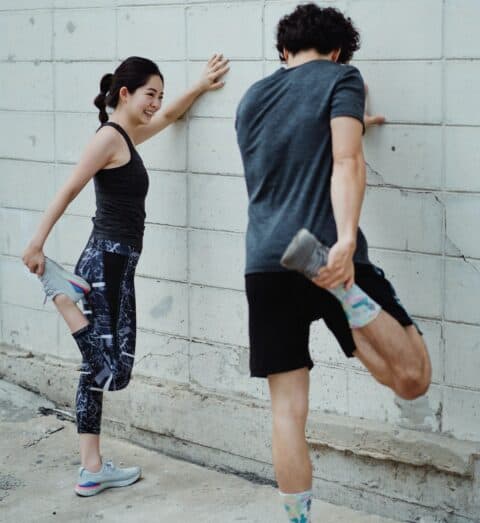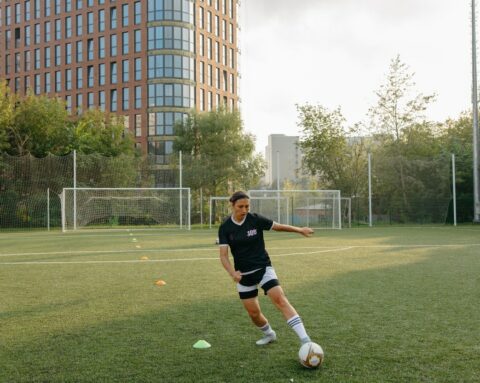Patella Tendinopathy
Patella Tendinopathy is a knee injury caused by overuse. When you experience repeated stress to the patella, it can push past the coping capacity of the tendon. You will most often see patella tendinopathy occur in sports such as basketball and volleyball; as a result, It is commonly referred to as Jumper’s Knee.
Anatomy:
Your patella tendon can be found just below the knee cap. The tendon is attached to the tibia and the patella. Its primary role is to transfer the force of your quadriceps muscle through your kneecap and shinbone. When you bend your knee from a straight position your quadriceps are crucial in allowing you to keep control of the movement. This is commonly seen when walking downstairs or landing from a jump. It is also particularly prevalent in any sports that involve running.
Patella tendinopathy is commonly referred to as jumpers knee as the tendon is under the most stress during jumping and landing motions. When jumping, your quadriceps muscles absorb the force of the landing by allowing for a controlled knee bend. ⠀⠀
If you play a sport that requires excessive landing or jumping, it is common for your patella tendon to become strained. Overtime these motions will cause micro-trauma within the tendon which can exceed the rate at which your tendon can repair. If this is the case you may experience dysfunction and pain resulting in patella tendinopathy. When you sustain an acute injury to the tendon which is not properly healed patella tendonitis can develop. This form of patella tendinopathy is far less common. The more common version of patella tendinopathy occurs due to degeneration of the tendon over time from repetitive micro-damage.
Symptoms:
Here are the main symptoms and signs of patella tendinopathy:⠀
– Your tendon may appear thicker than the tendon on the unaffected side. ⠀
– You may experience knee pain over the patella tendon which can become heightened if you land, jump, run or sit for a prolonged time. ⠀
– Experiencing tenderness that is localised over the patella tendon. ⠀
– Your tendon may feel very tight or stiff when you wake up⠀
If you experience any of these symptoms it is important to contact your myotherapist as soon as possible.
Causes:⠀
Many potential factors can cause or contribute to the injury occurring. Poor lower limb biomechanics are a common cause of patella tendinopathy, this can include:⠀
-Poor Posture⠀
-Poor Knee Control⠀
-Poor Foot Control⠀
Another common cause of patella tendinopathy is observed in training errors such as:⠀
-Sudden Increase In Training Intensity⠀
-Training On Rigid Surfaces⠀
-Having Poor Flexibility⠀
-Rapid Increase In Training⠀
-Tight Hamstring Muscles
What Are The Phases Of Tendinopathy? ⠀
There are four phases of tendon injury you could experience. Phase one of the tendon injury has the quickest and best recovery outlook whilst phase four will require surgery and more extreme treatment options. ⠀
If you experience a Phase 1 injury you will almost always recover normally! In Phase 2 the injury rate will be larger than the repair rate. In this state, you need to prevent deterioration and progression to cell death. ⠀
Phase 3 is known as degenerative tendinopathy. In Phase 3 cell death will occur and recovery is more difficult. Phase 4 is a tendon tear or rupture. In this phase surgery is often the only option. ⠀
It is important to have your myotherapist professionally analyse your injury phase to provide the appropriate treatment. Some certain exercises or methods can only be undertaken at certain stages of the healing process.
Diagnosis:
Your tendon injury will be diagnosed by your myotherapist asking important questions about your past health, your symptoms and exercise regime. ⠀
Following this, you will then undergo a physical examination to determine the diagnosis. if your symptoms do not improve after early treatment than steps such as an MRI or ultrasound scan may be required.
Initial Treatment:
Your tendon injury, in most cases, can begin treatment at home by following through with these steps:⠀⠀
– Speak to your myotherapist as soon as possible to assess your biomechanics and begin an eccentric strengthening program⠀
– Avoid activity that makes your pain worse by resting the painful area⠀
- Apply cold packs or ice on and off for 20 minutes during the first 72 hours
- Do gentle stretching and slow-motion exercises to prevent stiffness
Return To Activity:
Your myotherapist can assist with all recovery to do with knee pain. Patella Tendinopathy is just one of the potential injuries that can occur in that area. Your myotherapist can correctly diagnose your injury which significantly improves your immediate treatment outlook. ⠀
Following this correct diagnosis, you will be able to begin the injury rehabilitation and management to return to your chosen activity in as little time as possible!
Common Treatment Options:
Your patella tendinopathy treatment in the early stages will utilise methods such as cryotherapy, taping techniques, de-loading braces or electrotherapy options. In the early stages, it is common to require a lot of rest and to avoid doing anything that causes any discomfort to the knee.⠀
Usually, you will be able to begin to do some basic exercises (provided by your myotherapist) which are little to no Impact activities. This allows you to maintain both your muscle strength and cardiovascular fitness. Following this, your myotherapist will begin to progress your recovery by following a strengthening program that is specific to your needs. These exercises will improve both the strength of your knee as well as the muscles and tendons around the area. ⠀
If your injury does not improve with early treatment or your symptoms are severe; tests may be required such as ultrasounds of MRI to determine proper recovery options.






